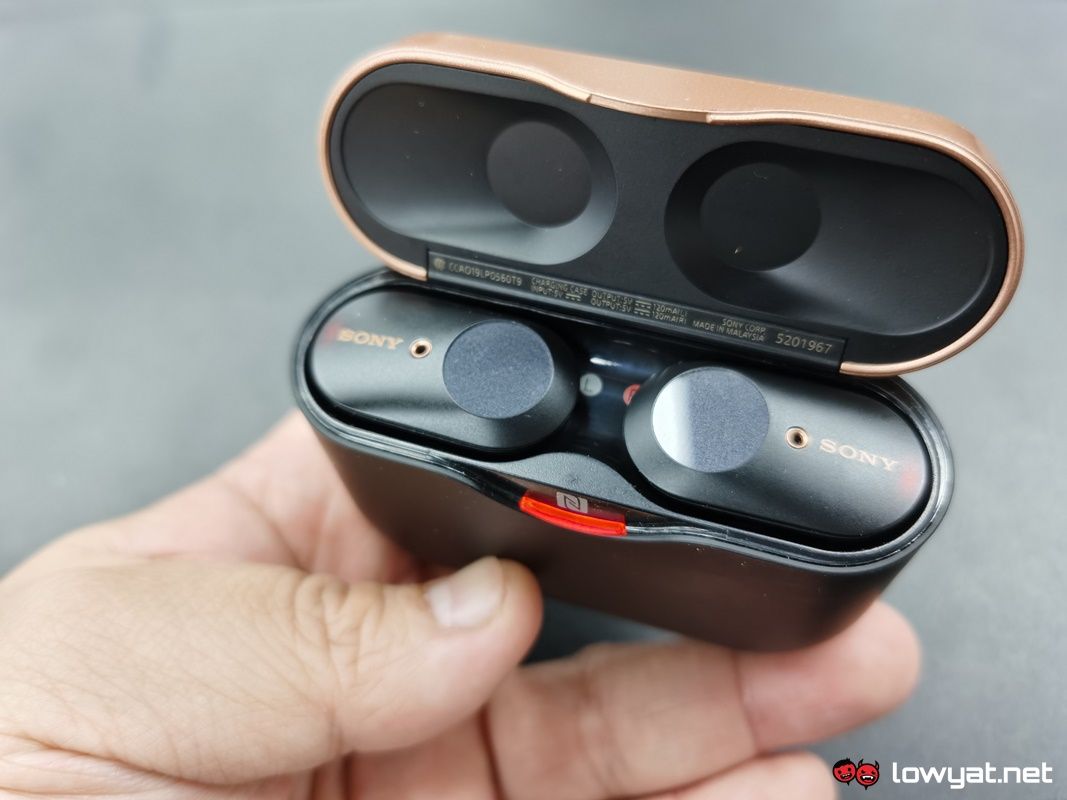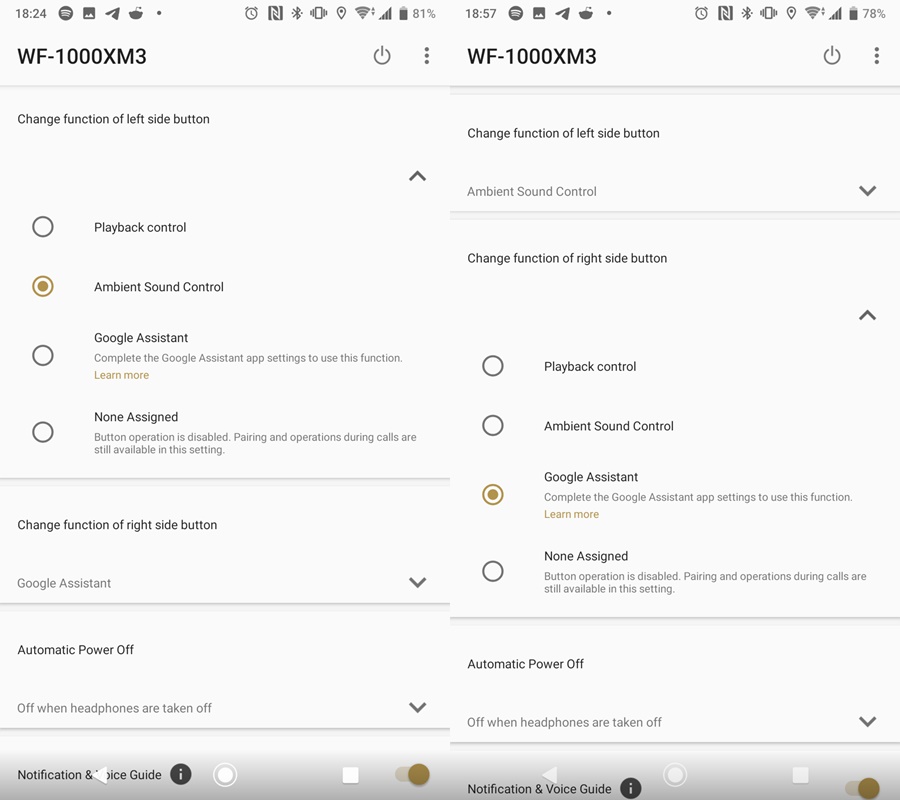Sony WF-1000XM3 Lightning Review: A Follow-Up Worth Waiting For
At IFA 2017, Sony introduced the WF-1000X, its first-generation wireless earbuds to the world. Unfortunately, it failed to live up to the hype; the design was less than perfect, its performance was abysmal, as was its overall battery life.
Fast forward to today, and the WF-1000XM3 comes with the improvements and features that its predecessors should have been given in the first place.
What Is It?
In essence, the WF-1000XM3 is basically a complete overhaul of Sony’s first attempt at making wireless earbuds. From the aesthetics of the earbuds to the redesigned shape of its charging case, Sony has spared no expense on this audio accessory.
Like Sony’s more premium WH-1000XM3 over-ear headphones, the WF-1000XM3 is packed with nearly identical features as its sibling. And yes, that includes the same noise-cancelling technology and high-end audio quality too.
Is It Any Good?
On the aesthetic side of things, the WF-1000XM3 is perhaps one of the most well-designed pair of earbuds I have used. Out of the box, the earpieces come with a total of seven pairs of ear tips. It’s an uncommon form of generosity, and one you don’t see the majority of other audio brands doing with their own wireless earbuds.
There’s also the shape of the WF-1000XM3. As I said at the start of this review, the earbuds’ design is a far cry from its predecessor. They’ve been elongated slightly for better in-ear stabilisation, while the back of the earbuds is flat, with the touch sensors clearly visible on each unit.
Once you find the right ear tip size, fitting them into your ears is effortless. Using the WF-1000XM3, I don’t have the fear that either of the earbuds is going to fall out of my ear while walking or running.
Just like its bigger brother, the WH-1000XM3, the WF-1000XM3 is equipped with Sony’s adaptive noise-cancelling technology. Specifically, the earbuds can activate two modes: active noise-cancelling or Ambient sound mode. Both of which can be customised via Sony’s Connect app on Android.
Moving on, I applaud Sony for the massive improvement to the WF-1000XM3’s battery life. By comparison, its six-hour (eight, if you turn off noise-cancelling) battery is double what its predecessor provided, and that’s with continuous usage of the earbuds. Of course, like all modern earbuds, its charging case carries up to an additional 32 hours, which translate to two or three charges, depending on the mode you’re using.
Regarding audio quality and performance, the WF-1000XM3 is relatively decent, if not borderline impressive. Sound staging is surprisingly accurate, albeit a little soft on the volume. Its strengths are more focused on highs and mids, making them perfect for music that are heavy with strings and vocals within the tenor and soprano range.
The Bad Stuff. Tell Me.
While the WF-1000XM3 are Sony’s most finely crafted earbuds to date, it does sadly, come with its own set of flaws. As finely tuned as they are, one issue I hold against the earbuds is its maximum volume setting, and at the phone’s highest volume level, they just don’t have that “oomph” that you get at louder volumes.
To be clear, I’m not saying that the WF-1000XM3 are not loud. I just think that Sony could have raised that proverbial roof a little higher.
Speaking of “oomph”, there’s another performance feature the WF-1000XM3 is not all about: the bass. Frankly, I don’t find the earbuds’ lack of a decent bass all that surprising; it is, naturally, not the same as the WH-1000XM3, so it’s only natural that it would be lacking in certain features.
Another thing that the WF-1000XM3 sorely lacks is the ability to manually control the volume via the touch sensors. You can change the buttons to play and pause your current music track, set it to activate Google Assistant, or enable it to activate its noise-cancelling mode. But there is no option that allows you to control the earbuds’ volume from either sensor.
Also, I know that the WF-1000XM3 uses Sony’s new left and right relay technology for better connectivity to a mobile device, but that sadly doesn’t make it any less susceptible to areas with high interference that in turn, causes the audio to cut out or stutter. To its credit, the earbuds don’t cut out as badly as the Klipsch T5 True Wireless, but interference is still interference, wherever it manifests.
Oh, and lastly, the WF-1000XM3 doesn’t carry support for Qualcomm’s aptX technology. It supports AAC3 and Sony’s own DSEE HX technology, but ultimately, there’s no reason Sony couldn’t have included the audio technology with its earbuds. Especially when other competitor brands and their earbuds already do so.
Should I Buy It?

If I were to summarise, the Sony WF-1000XM3 could very well be one of many dictionary definitions of the “If at first, you don’t succeed” proverb. Rather than give up on the idea entirely, it chose instead to overhaul, rework, and redesign its the earbuds from the ground up. That said, there are still some elements that I wish Sony could’ve fixed up.
At RM949, it’s a near sight cheaper than the WH-1000XM3 and even comes with the same noise-cancelling technology and audio fidelity. My only issues with the WF-1000XM3 are that I wish Sony had just included support for Qualcomm’s aptX audio technology, as well as a volume control option for the earbuds’ sensors.
On that note, I believe that the WF-1000XM3 would make an ideal choice for the consumer who isn’t sold on the idea of over-ear headphones.
The post Sony WF-1000XM3 Lightning Review: A Follow-Up Worth Waiting For appeared first on Lowyat.NET.
from Lowyat.NET https://ift.tt/2NXFS1Q
Labels: Lowyat







0 Comments:
Post a Comment
Subscribe to Post Comments [Atom]
<< Home